

State of Smart Manufacturing Report
How global manufacturers are harnessing emergent technology to maximize workforce potential, reduce risk, increase quality and deliver sustainable growth
A letter from our CEO and Chairman
Creating the Future of Industrial Operations
Welcome to Rockwell Automation’s 2024 State of Smart Manufacturing Report.
Rockwell Automation, together with our customers and partners, is creating the future of industrial operations. While the technology has certainly changed over our 120 years, our approach has been proven time and again, around the world and in diverse industries.
In this year's State of Smart Manufacturing Report, we explore current disruptors, including emerging technologies like industrial AI, and their potential to alleviate the biggest challenges facing manufacturers.
We take a uniquely human-centric approach to automation; the winning hand is technology thoughtfully applied by an engaged and inspired workforce. This is even more essential with the rapid acceleration of technology adoption, driven first by the necessities of the pandemic, continuing with the need for
greater resilience and underscored by subsequent supply chain shortages. Resilience includes the ability to weather these shortages in the future, to deal with pervasive scarcity of skilled labor and to create more sustainable business models. The results of our survey reflect these views.
We are pleased to share these results with you and hope that this global benchmark report provides a guide for successful decision-making throughout 2024, driving the positive business outcomes that will deliver a competitive edge, profitable growth and a sustainable future.
With best wishes for a productive and successful 2024,

Blake Moret Chairman and CEO, Rockwell Automation


Key report results
94 %
95 %
expect to maintain or grow their workforce as a result of smart manufacturing technology adoption are using or evaluating smart manufacturing technology, up from 84% in 2023
98 %

have a sustainability / ESG policy in place, with almost half of those having company-wide formalized policies

Executive Summary

The Industrial GenAI Revolution: Shifting from Vision to Reality
Generative artificial intelligence (GenAI) rocketed up the technology priority list over the last twelve months, creating fierce demand for industrial applications embedded with this transformative technology.
Emerging Technologies Drive Change
Looking to supplement and amplify the workforce, cobots, autonomous mobile robots (AMRs), automated guided vehicles (AGVs) and wearables all ranked prominently in new areas for technology investment in 2024.
expect to maintain or grow their 94 %
83 % workforce as a result of smart manufacturing technology adoption
anticipate using GenAI
in their operations in 2024
technology by the end of 2024 plan to be using wearable 81 %
Change management
is the top workforce-related obstacle in 2024
Rising Cyber Threats and the Impact on Risk and Resiliency Operations
The lines between OT and IT continue to blur, increasing the connectivity between digital and physical operations. This elevates the need for cybersecurity awareness and action to mitigate the risk of a breach or attack.
for the first time, ranking 3rd overall broke into the Cybersecurity top 5 external risks
ranked as the Cybersecurity behind only Cloud / SaaS for ROI, GenAI ranked #2 technology investment over the next 12 months
#1 skill employers are seeking in 2024
GenAI is the #1 new area for #2 most impacted by AI in the next three years, just behind quality Cybersecurity predicted as
Overview
Over 1,500 manufacturers around the world contributed to this year’s State of Smart Manufacturing Report. The survey reveals optimism as advanced industrial operations technology delivers results that offer hope in the face of evolving economic conditions, labor shortages, skills gaps and cybersecurity concerns.
WHAT IS Smart Manufacturing?
The 9th annual edition of the State of Manufacturing Report is the largest to date. 1,567 decision-makers from 17 of the top manufacturing countries took part, nearly two-thirds of whom (64%) work for firms with over $1B in revenue

Smart Manufacturing is the intelligent, real-time orchestration and optimization of business, physical and digital processes within factories and across the entire value chain. Resources and processes are automated, integrated, monitored, and continuously evaluated based on all available information as close to real time as possible."
MESA International
This report from Rockwell Automation, in association with Sapio Research, includes a plan for taking action alongside the research findings to help you turn insights into action. Refer to our glossary of AI-related terms used throughout the report.
What are examples of smart manufacturing technology?
INDUSTRIAL OPERATIONS
Manufacturing Execution Systems (MES)
track and document the transformation of raw materials into finished goods, providing real-time production management to drive enterprise-wide compliance, quality and efficiency.
Distributed Control Systems (DCS) use decentralized elements to control dispersed systems, such as automated industrial processes or large-scale infrastructure systems.
Computerized Maintenance Management Systems (CMMS) help organizations track and manage maintenance and repair activities for their facilities, equipment and other assets in one place.
Asset Performance Management (APM) combines process, operational and machine-level data through dashboards to monitor machine and plant health.
Design
& Visualization
tools transform raw ideas into intuitive HMIs and immersive VR simulations for smarter, faster production.
Power Control drives continuous flow of valuable process and diagnostic data that informs the design environment, visualization systems and information software.
Industrial Control Systems
Production Monitoring provides seamless connectivity to machines on the plant floor, delivering transparent, real-time operational KPIs like Overall Equipment Effectiveness (OEE).

improve processes and production quality at every stage of your operation and provide seamless data exchange.
Enterprise Resource Planning (ERP) automates front- and back-office processes across business management and related functions.
Supply Chain Planning (SCP) combines data from multiple departments to sync demand and supply forecasting to improve inventory accuracy and production management.
Quality Management Systems (QMS) standardize and automate quality documentation, processes and measurements.
Production Logistics
delivers an orchestrated, agile, zero touch material flow through manufacturing operations with autonomous mobile robots (AMRs).
Analytics use data to solve manufacturing bottlenecks, optimize output and quality and provide new insights, tapping into the power of Industrial AI.
Robotics accelerate autonomous / semi-autonomous operations and contribute to systems that are more intelligent, intuitive and flexible.
Smart Devices are self and system-aware assets that acquire, process and monitor operating data.
THE CURRENT STATE OF
SMART
MANUFACTURING
Manufacturers report a tough operating climate of inflationary pressures, high energy prices and ongoing skills shortages. The drive to find incremental efficiencies pervades the organization, from the boardroom to the factory floor.

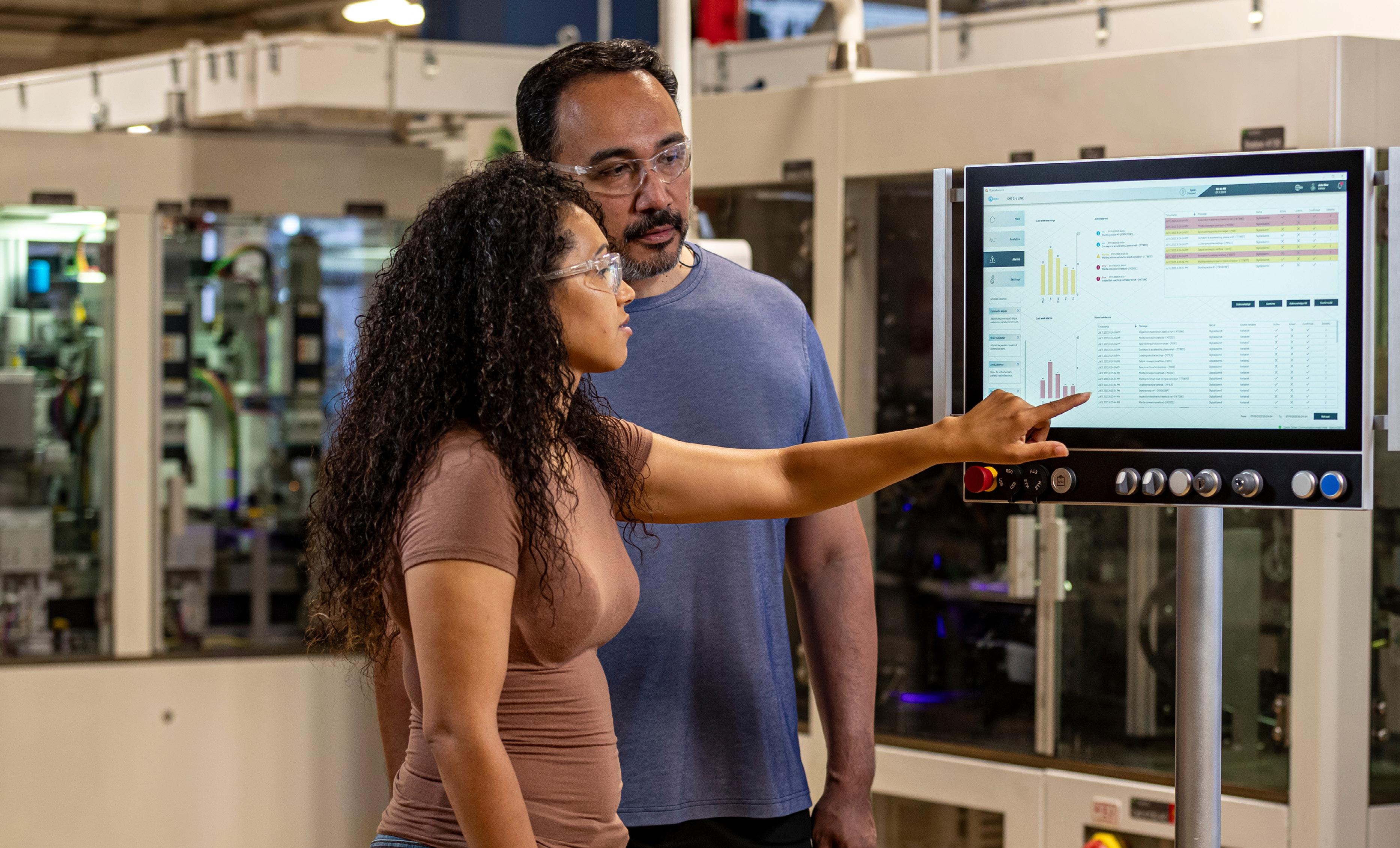

Industry obstacles and outlook
For the second year in a row, inflation is named as the primary obstacle to growth. This year it is compounded by rising energy costs, which ranked second.
Cybersecurity ranked third, appearing in the top 5 for the first time. Risks to OT and IT networks are increasing from the interconnectivity of digital and physical infrastructure.
Workforce issues continue to dampen growth, ranking in the top 5 for both external (4th) and internal (1st) obstacles. Deploying and integrating new technology remains a top concern, highlighting the importance of the relationship between people and technology to drive results.
Supply chain disruption dropped in the rankings this year, but it is important to remain vigilant with a strategic approach to planning in order to mitigate future supply chain instability.



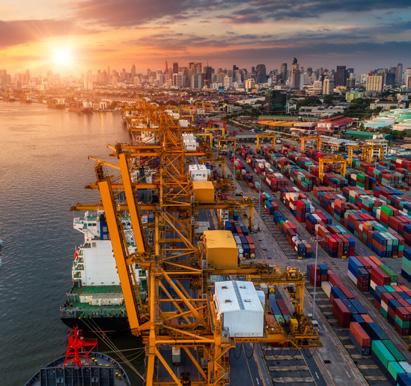
EXTERNAL OBSTACLES
INTERNAL OBSTACLES
Technology investment up 30%
Prompted by inflationary pressures and rising energy costs, manufacturers are stepping up technology investment to counter risks.
Adoption of technology is seen by manufacturers as the best way to mitigate against both external and internal risks.
Spending in this area increased 30% year-over-year: from 23% to 30% of operating budget.
AI use cases deliver outcomes, drive ROI
BIGGEST ROI
Q. Which of the technologies that your company has invested in had the biggest ROI over the last 12 months? Select top 3. Base: 1562 Cloud / SaaS
AI / ML
Supply Chain Planning (SCP)
Advanced analytics (using AI / ML)
Robotic Process Automation (RPA)
Robotics
Manufacturing Execution System (MES)
Enterprise Resource Planning (ERP)

AI / ML deliver bigger business outcomes than all other smart manufacturing capabilities.

Results show that AI is core to technology strategies and roadmaps. Adopters are seeing tangible results, with only Cloud / SaaS delivering more ROI than GenAI and causal AI.
AI / ML
Scalability to meet business needs and drive profitable growth CAPABILITIES THAT DELIVER OUTCOMES
Process automation and optimization
Cybersecurity
Adaptability / agility to keep pace with competition and a changing market
Q. What smart manufacturing features / capabilities do you think drive the biggest business outcomes? Select all that apply. Base: 1567
Skills gap reduces competitiveness
For two years in a row, manufacturers have cited a lack of skilled workforce as the top reason they will struggle to outpace the competition.
Respondents plan to use new and emerging technology to amplify their workforce, fill the skills gap and maintain quality against a backdrop of employee turnover. Through increased use of smart manufacturing technology, 94% expect to hire more workers or repurpose workers to new or different roles.
Q. By increasing your use of smart manufacturing technology in the next 12 months, which best describes changes to your workforce? 'We will…’ Base 1567

Ability to use data to make decisions
Q. Please read the statement below and select the answer options that apply to your organization: “My organization lacks the _____ to outpace the competition over the next 12 months.” Select all that apply. Base: 1567
Better data management needed to fuel AI and empower teams
Respondents believe of the manufacturing industry are using data to fuel AI / ML and optimize processes. However, those surveyed believe their own organizations use data effectively.
Leaders in the industry are accessing contextualized data to drive informed, real-time decision-making.
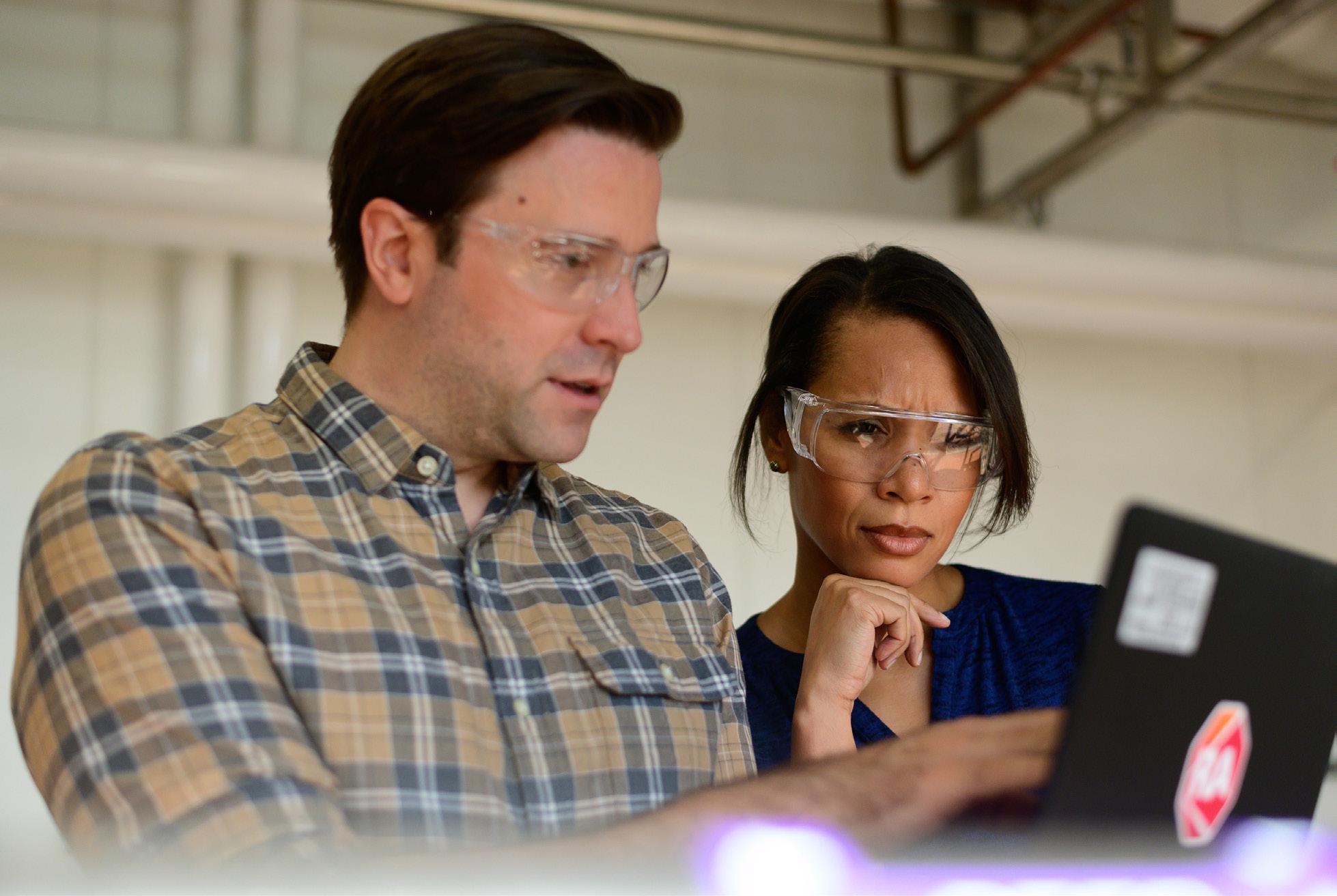
"As IT and OT worlds continue to integrate, and with subdued customer demand in many sectors, continuing above average historical rates of inflation, rising energy costs and a changing manufacturing workforce, the adoption of IT technology in OT environments together with new as a service offerings is key to competitive advantage."
HOW LEADERS USE DATA
Mark Watson Senior Director, Government & Manufacturing, Omdia, Omdia Tech Trends to Watch 2024
Sustainability and ESG policies increasingly driven by energy concerns
have a
company-wide sustainability or ESG policy of organizations have some form of sustainability or ESG policy
We’ve seen an increase in the adoption of sustainability and ESG policies over the last year. The number of organizations with some form of policy increased to 98%, and those with formal policies is 86%, up from 78% in 2023.
Factory floor processes see most smart manufacturing adoption
Manufacturers are upgrading their networking infrastructure and investing in more connected hardware devices. More data from systems allows companies to capitalize on their software investments and further empower their workforce with information to optimize operations in real time.
Manufacturers are benefitting from modular, scalable smart manufacturing solutions that can be deployed quickly at a lower cost than more highly complex, rigid legacy systems. These practical applications require fewer resources, are easier to integrate and deploy and deliver a faster return on investment.
Q.
MANUFACTURERS'
BIGGEST CHALLENGES
The severity of today’s global labor shortage and skills gap intensifies the problem of attracting, managing and retaining skilled workers, but there is hope.
New and emerging technology, like GenAI, robotics and wearables, are filling skills gaps and amplifying effort rather than replacing workers.



Industry 4.0 skills shortages
Skills shortages are holding manufacturers back. Attracting skilled employees and training the workforce to adapt to new systems and software will be vital for success in 2024. This year communication / teamwork, knowledge of smart technology and cybersecurity practices and standards are the #1 skills employers are seeking.
BARRIERS TO SMART MANUFACTURING ADOPTION
Cost / Expense
Lack of skill set to implement
Lack of skill set to optimize
Employee resistance to change
Replacing / upgrading legacy systems
Technology infrastructure readiness / data readiness
Lack of commitment to or understanding of Organizational Change Management (OCM)
Leadership resistance to change
Q. What are the barriers to adopting smart manufacturing? Select all that apply. Base: 1567
Quality #1 focus for smart manufacturing
Improved quality is the number one outcome respondents hope to achieve from existing smart manufacturing
The focus on cybersecurity intensifies

"As the technology landscape becomes more complex, and OT systems are further integrated into enterprise IT networks, the opportunities for cyber attacks quickly increase.
Manufacturers are looking to a combination of human skill and emerging technology to strengthen their security posture in the face of this growing concern.
for the fist time, ranking 3rd overall Cybersecurity broke into the the top 5 external risks
See page 8

Cybersecurity ranked as the #1 skill employers are seeking in 2024
See page 16
Cybersecurity ranked #2 use case for AI / ML
over next three years, just behind quality control
See page 17
Cybersecurity ranked 3rd for driving biggest outcomes through smart manufacturing technology
See page 10
With over 71% of all ransomware attacks on industrial organizations focused on manufacturing, ransomware continues to broadly target many manufacturing sectors and subsectors. As ransomware activity increases, it results in more risk for OT networks, particularly networks with poor segmentation.”
Dragos, 2023 OT Cybersecurity Year in Review
Employees navigating seismic change
Helping employees adapt to seismic shifts within the industry will distinguish successful manufacturers from the rest.
Change management and training employees on updated processes are the top two workforce-related obstacles.
Number three on the list is also linked: helping employees stay engaged and feel valued in their roles.
Training current employees on updated processes
Change management
Employee engagement (feeling purpose / value in their role)
Rising cost of labor / skilled staff
Employee retention

Improving efficiency top reason for pursuing sustainability and ESG
Reducing energy usage, repurposing / recycling and maximizing resources are must-haves as technology is being used to squeeze every ounce of efficiency from operations.
Manufacturers are turning to smart manufacturing technology to achieve their sustainability and ESG goals, with a focus on improving quality, cutting costs and driving OEE.
The data divide
Manufacturers with annual revenues less than $500 million use only 38% of their data effectively, compared to those with revenues of over $30 billion who effectively use more than half (51%).
"While ARC believes recent generative AI breakthroughs are an evolutionary step in the domain of Industrial AI, its impact on the user interaction paradigm for industrial software solutions, and democratization of access to AI is likely to be revolutionary."
Colin Masson Director of Research, ARC Advisory Group
How
Leaders
Are
Embracing Industrial AI ARC Advisory Group

Size of manufacturer matters when it comes to using data effectively
Manufacturers with revenue more than $30B
Manufacturers with revenue less than $500M
Q. What percentage of the data you collect is used effectively? Select one. Base: 1567
Adversity accelerates transformation
The vast majority of manufacturers (83%) say the obstacles they face are accelerating digital transformation.
This figure rises above 90% in Brazil, China, India, Japan, Saudi Arabia and the United Arabs Emirates (UAE).
Given supply chain disruptions over the last few years, the warehouse and fulfilment industry sees the highest acceleration of digital transformation, followed by the renewable energy and chemical sectors.
accelerating digital transformation say the obstacles they face are 83 %
THE FUTURE OF SMART MANUFACTURING
Today’s emerging technologies will be tomorrow’s table stakes, and organizations that become early adopters will be set up for future success.
Balancing people, technology and sustainability and ESG practices will be key to industry leadership.




The race to capitalize on AI
GenAI and causal AI, cobots and AMRs have already been adopted by manufacturers to enhance and complement the workforce, while reducing errors, increasing speed to value and improving quality.
have already invested or plan to invest in AI / ML this year.
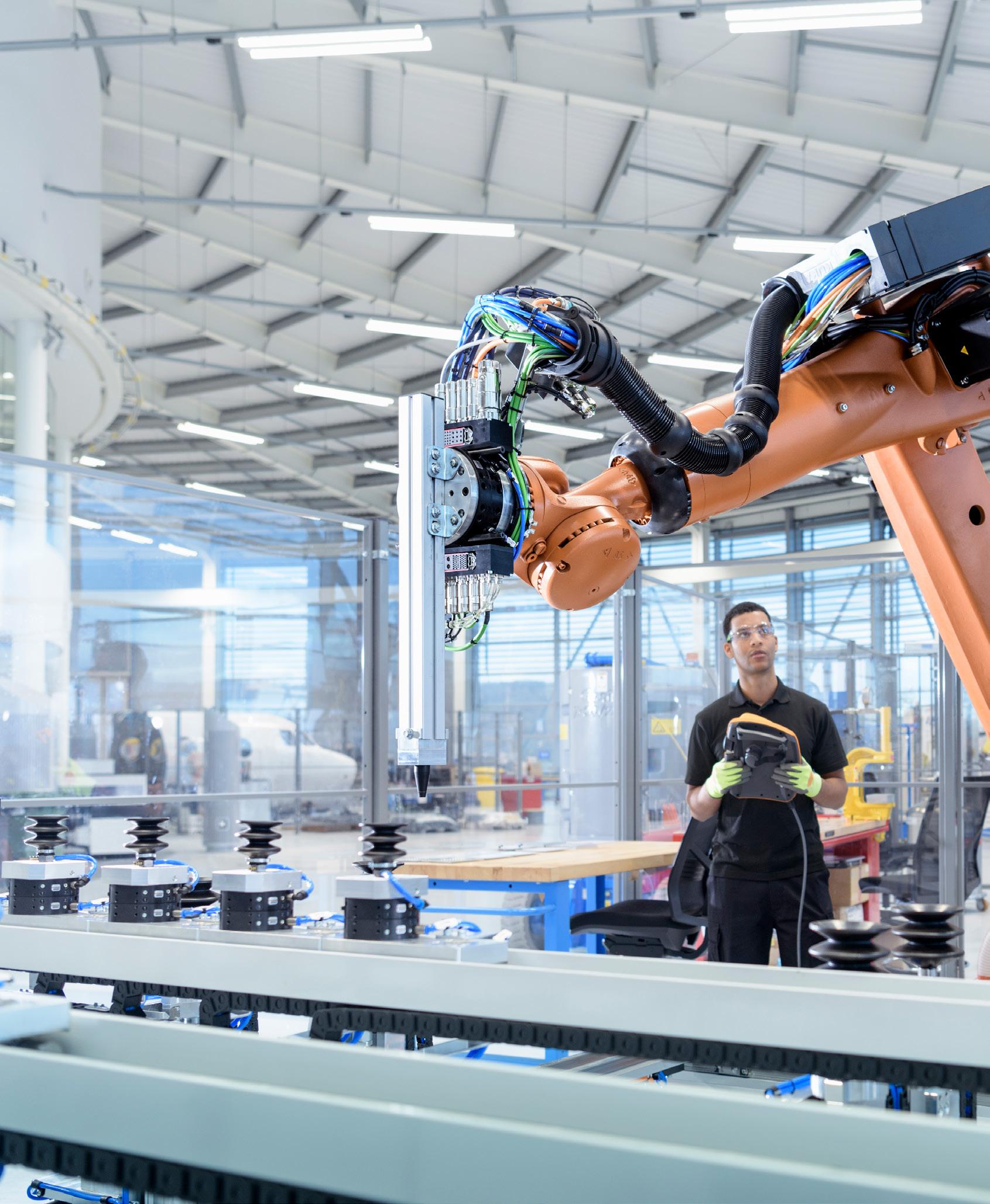
Automation crucial for success
The top ways manufacturers are addressing the industry’s labor shortage and skills gap are increasing automation and introducing AI / ML.
Use of automation, smart manufacturing technology and AI / ML will increase over the next 5 years to drive positive business outcomes, along with investment in employee training and programs to accelerate successful technology adoption and optimization.
Increasing automation
Introducing AI / ML technologies
Leveraging remote work to access a wider talent pool
Introducing flexible scheduling (working hours as-able, short shifts, etc.)
Adding / using technology to create more engaging jobs
Q. How are you addressing the manufacturing industry’s labor shortage and skills gap? Select all that apply. Base: 1567
Increased automation
Adopting smart manufacturing technology
Increased use of AI / ML
Better use of real-time data to make decisions
Increased training and employee programs
"At Microsoft, we see a future where intelligent factories powered by people using AI and Generative AI become the norm, not the exception. Emerging technologies delivered through partnered ecosystems are helping to pave the way for sustainable, autonomous operations that redefine productivity. Imagine production lines optimized by data insights, robots collaborating seamlessly, and materials sourced responsibly. This isn't just a vision, it's a reality we're building together. Let's unlock the future of manufacturing, one innovation at a time."
Gary Nafus Vice President, US Manufacturing
Sustainability and ESG at heart of risk mitigation

TOP 3 APPROACHES TO MITIGATE INTERNAL RISK
"No matter where you are in your journey, IT is a critical enabler for that (sustainability) transformation and for value generation through corporate sustainability practices, and it is important to understand how to best leverage technology to move up to the next stage."
Bjoern Stengel, Global Sustainability Research Lead, Sustainable Strategies and Technologies at IDC IDC FutureScape: Worldwide Sustainability/ESG 2024 Predictions
Manufacturers have signaled their intent to make sustainability and ESG a core priority. The top way respondents are mitigating against internal risk, alongside upskilling existing talent, is adopting technology for tracking and quantifying sustainable practices, an increase from third place last year. Adopting technology for tracking / quantifying sustainable practices Upskilling existing talent Adopting smart manufacturing technology 1 2 3 Q. How is your organization mitigating the internal risk mentioned in the
Technology investment drives long-term business resilience
Despite current challenges and setbacks, manufacturers are looking at their businesses through a long-term lens. By investing in technology, they expect to elevate their competitive advantage and build business resilience into the future.

At the same time, a third of respondents selected Emergency / Immediate need due to broken, non-operational technology, which highlights the global obsolescence organizations are facing in 2024.
AI will improve quality and lower risk
Over the next three years, the areas most impacted by AI will be two of manufacturing’s evergreen concerns: maintaining quality and reducing risk, specifically cybersecurity.
Manufacturers cite AI as the technology that will have the biggest impact on workforce challenges.
– According to Gartner®,
"By 2026, more than 80% of enterprises will have used generative AI APIs, models and/or deployed generative AI-enabled applications in production environments, an increase from fewer than 5% today.” Top Strategic Technology Trends 2024, Democratized Generative AI, Gartner, 2023 2024 Gartner Top Strategic Technology

Leaders will balance people, process and technology
When asked about leadership obstacles, manufacturers identified two interlinked areas: assessing business and technology / talent fit and effectively managing people and resources. Respondents recognize that it’s not an either / or scenario. Both adopting the right technology to complement their team and managing their team to capitalize on resources will be equally crucial.
"The workforce of 2019 is not coming back. Developing a sustainable workforce strategy is critical to successfully navigate daunting manufacturing challenges. Leaders are winning the war for talent by embracing this new reality and with a laser focus on three imperatives:
1. Total Employee Experience
2. Servant Leadership
3. Connected Frontline Workforce (CFW) Applications
Allison Kuhn, Principal Analyst at LNS Research Attract and Retain a Quality Workforce with Future of Industrial Work Initiatives
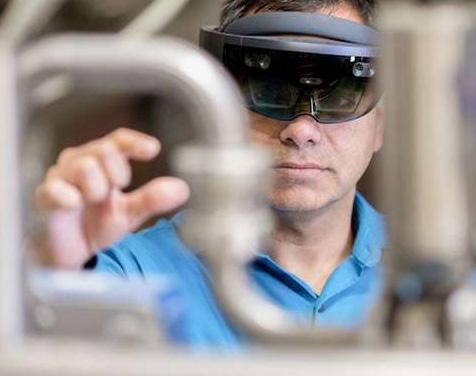
matching technology and talent to business need
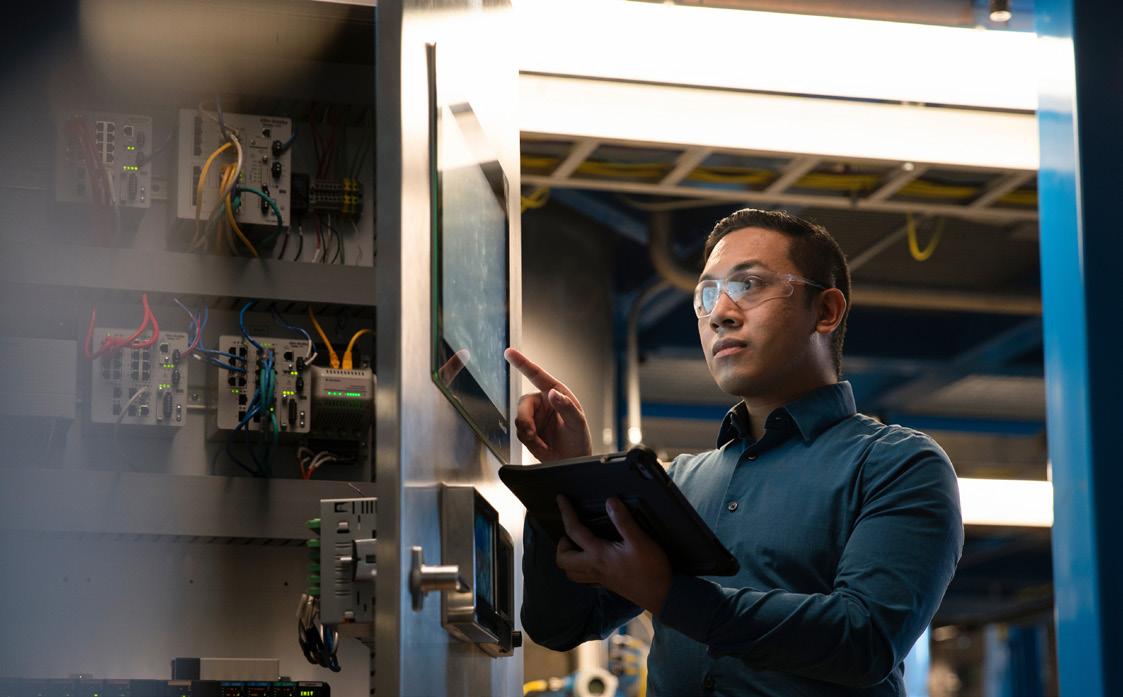
LEADERSHIP OBSTACLES

31 % effectively managing people and resources
Q. Which of the following are the biggest leadership obstacle(s) your organization faces in the next 12 months? Select all that apply. Base: 1567
TAKING ACTION
Smart manufacturing technology enables manufacturers to stay competitive, increase agility and unlock long-term opportunities by connecting and automating the business.
Use the information in this report to plan or continue your digital transformation journey.



I'm ready to begin an assessment and develop a strategy
Manufacturers start their digital transformation journey in one of two places: 2
I have a strategy and I'm ready to start piloting program implementation

Realize the promise of digital transformation
Maintain and continuously improve the solution, architecture and people infrastructure for sustained and widespread value realization.

SCALE
Strengthen the solution through updating functionality, finalizing the architecture, setting system specifications and defining plant specific customization rules. Scale core capabilities to new assets, lines and plants while expanding to add additional use cases.
I'm ready for assessment starts here I have a strategy starts here
IDENTIFY your greatest needs
Gather the people connected to the change. Diverse perspectives clarify the key opportunity areas, whether disconnected systems, people, processes, supply chains, unexpected downtime, poor quality, lack of visibility, control and / or something else.






Manage the change, measure value, communicate results, iterate and improve





Prioritize use cases that address your opportunity areas, balancing value creation and time-to-value. Develop your business case tied to business imperatives and build a strategy and roadmap to orchestrate and focus efforts.






Focus on priority MVPs per your roadmap that deliver a full stack of capabilities in a specific area to realize value early. Aim to implement additional MVPs every 90-100 days to quickly build a foundation to scale.
Use case enablement requires an enterprise-level OT/IT architecture. Define your future state vision, identify the gaps and select potential solutions to fill the gaps.
8 steps to drive value, achieve success

Prove value vs. technology
Technology works. Find and prioritize specific digital use cases that solve manufacturing and operational issues.
Investments with a short-term payback
Transformations stall when ROI is slow. Build rapid, steady flow of value to drive adoption and self-funding.
Learn, iterate and improve
Long-term planning helps, but inflexibility can mean missed opportunities. Keep an eye on your digital vision while learning and adjusting your strategy and execution to build on proven value as it emerges.
Communicate progress and success Plan for scalability
To deliver desired outcomes at scale, plan for the optimal set of technologies with integration to the existing backbone. Focus on common work processes across the enterprise.
Foster enterprise collaboration
Siloed solutions are a dead end.
Enterprise (OT / IT) digital connectivity and collaboration unlock exponential value.
Momentum matters. Spread the word beyond the impacted group to build and maintain excitement for what’s possible.
Define and apply governance
Protect sustained value.
Embrace new ways of working, including adherence to process and data standards.
Equip and champion people
To get ROI from digital, empower people beyond introduction of new technology. Skills and mindsets that support new ways of working are key to success and driving self-service.
DEMOGRAPHICS /
FIRMOGRAPHICS

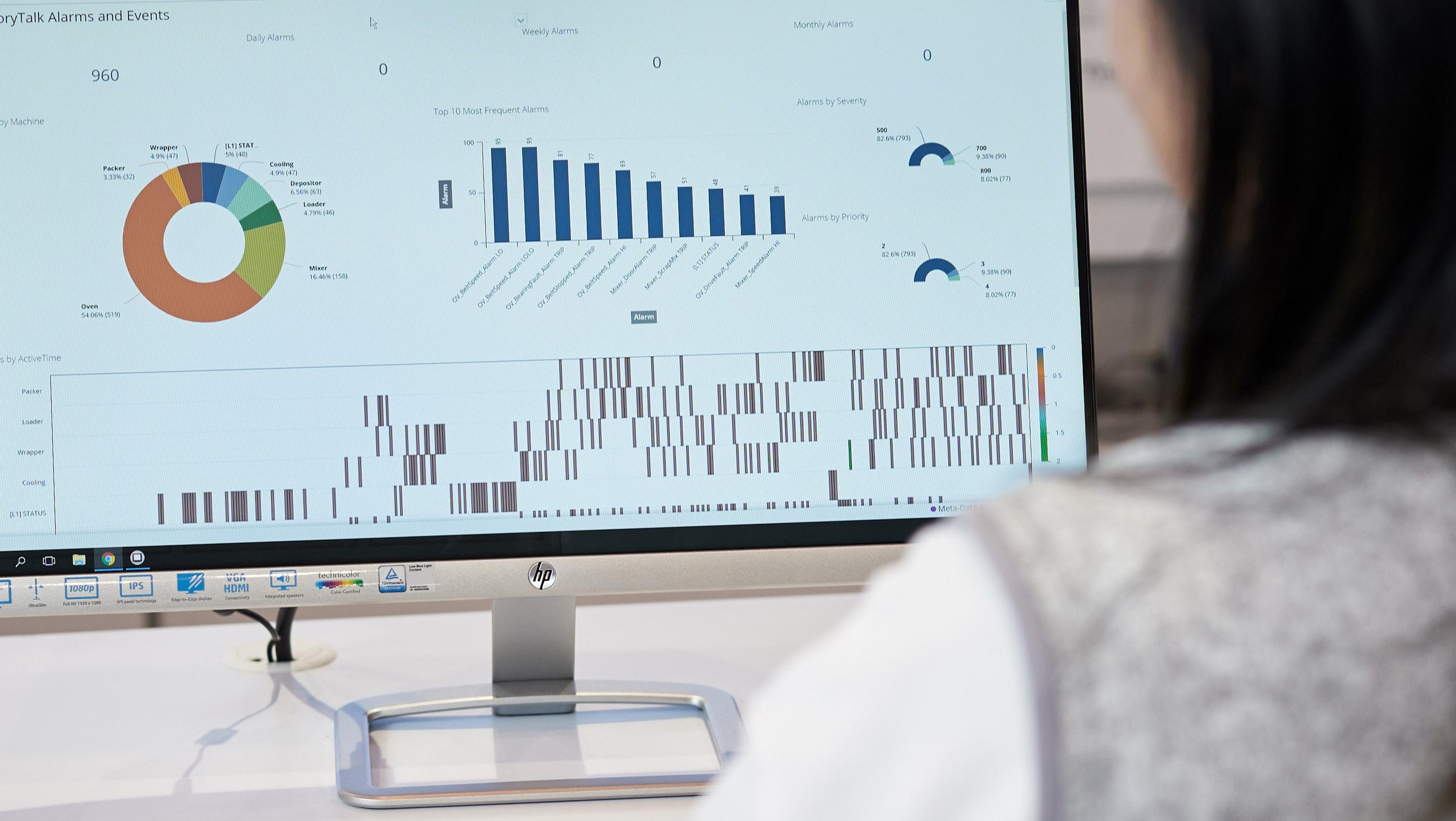

Appendix



Glossary of AI-Related Terms
Artificial Intelligence is fundamentally changing the Manufacturing Ecosystem
There are many AI-related terms used throughout this report that we define below for clarity.
Artificial intelligence (AI) applies advanced analysis and logic-based techniques, including machine learning, to interpret events, support and automate decisions and take actions.
Causal artificial intelligence (Causal AI) identifies and utilizes cause-andeffect relationships to go beyond correlation-based predictive models and toward AI systems that can prescribe actions more effectively and act more autonomously. It includes different techniques, such as causal graphs and simulation, that help uncover causal relationships to improve decision-making.
Deep learning
is a variant of machine learning algorithms. It uses multiple layers to solve problems by extracting knowledge from raw data, and transforming it at every level. These layers incrementally obtain higher-level features from the raw data, allowing the solution of more complex problems with higher accuracy and less manual tuning.
Industrial AI*
is the application of artificial intelligence in an industrial setting, focused around harnessing real-time data to feed learning processes that can predict, automate and interpret action from large and complex data sets.
Generative AI (GenAI) refers to AI techniques that learn a representation of artifacts from data, and use it to generate brand-new, unique artifacts that resemble but don’t repeat the original data. These artifacts can serve benign or nefarious purposes. GenAI can produce totally novel content (including text, images, video, audio, structures), computer code, synthetic data, workflows, and models of physical objects. GenAI also can be used in art, drug discovery, or material design.
Advanced machine learning (ML) algorithms are composed of many technologies (such as deep learning, neural networks and natural language processing), used in unsupervised and supervised learning, that operate guided by lessons from existing information.

